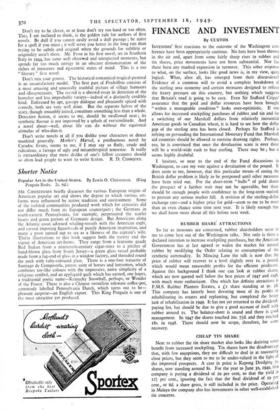Shorter Notice
Popular Art in the United States. By Erwin 0. Christensen. (King Penguin Books. 2s. 6d.)
MR. CHRISTENSEN briefly discusses the various European origins of American popular art and shows the degree to which various art- forms were influenced by native_ tradition and environment. Some of the isolated communities produced work which for centuries did not differ much from its European counterpart ; the Germans in south-eastern Pennsylvania, for example, perpetuated the scarlet hearts and green parrots of Germanic design. But Americans along the Atlantic coast adorned whaling-vessels with the American eagle, and carved imposing figureheads of purely American inspiration, and many a prow turned out to sea as a likeness of the captain's wife. Thirty illustrations to this book suggest both the variety and the vigour of American art-forms. They range from a fearsome gaudy Red Indian from a nineteenth-century cigar-store to a pitcher of hand-blown glass from South Jersey—a green glass vessel probably made from a fag-end of glass in a window factory, and threaded round the neck with ruby-coloured glass. There is a one-foot statuette of Santiago de Compostela, patron saint of horses and horsemen, which combines toy-like colours with the impressive, naive simplicity of a religious symbol, and an appliqued quilt which has earned, one hopes, a traditional poetic name—Kentucky Snowball, perhaps, or Wonder of the Forest. There is also a Chinese vermilion toleware coffee-pot, commonly labelled Pennsylvania Dutch, which turns out to be— pleasant surprise—an English export. This King Penguin is one of the most attractive yet produced.


































 Previous page
Previous page